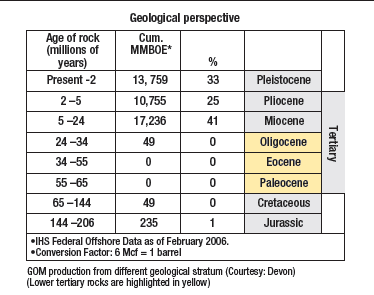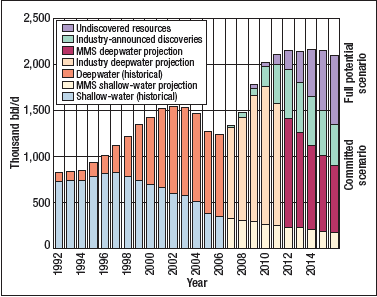By Victor Schmidt
Deepwater development has gone through a series of phases since the first projects in the 1990s. These early projects were done by the major oil companies and soon followed in the late 1990s by the large independents. Each wave of development followed the opening of a new trend, usually in deeper water that produced significant new challenges for the industry to overcome. Most recently, the industry has opened the Lower Tertiary trend with its deeper water, challenging subsalt exploration, through-salt drilling and higher pressure completions. Yet potential still exists for additional oil and gas development in the deepwater Gulf of Mexico (GOM).
OTC convened a panel of industry experts to discuss the topic “New Waves in the Gulf of Mexico” on Wednesday, May 7, 2008. The session was moderated by Sandeep Khurana, Facilities Advisor International Division of Devon Energy and Tom Miller, Project Interface Manager for Chevron. Experts on the panel included Russ Ford, VP Technical Americas for Shell E&P, Darrell Hollek, VP GOM Operations and Development from Anadarko, Chris Oynes, Associate Director of Offshore for the Mineral Management Service (MMS), US Dept. of Interior, Brian Smith, General Manager for Major Capital Projects with Chevron, North America and Neil Shaw, Sr. VP GOM of BP.
Deepwater exploration off the GOM shelf began with the Miocene trend, which continues to be developed. But, a new trend has been opened in deeper water-the Lower Tertiary (Oligocene, Eocene and Paleocene zones), which has untapped potential, Fig. 1. However, this new trend has to be developed in much deeper water and with minimal infrastructure; it also has a rig shortage until 2010 and high costs. The trend requires subsalt drilling for deeper lower-permeability reservoirs, has high viscosity oils and flow assurance problems from longer tiebacks. “The easy oil is over,” stated Mr. Khurana in his opening remarks.
 |
|
Fig. 1. The Lower Tertiary trend (yellow) has untapped potential. Image courtesy of Devon Energy.
|
|
Mr. Ford continued the list of challenges by mentioning low-energy reservoirs, logistics problems, the need for light weight and flexible floating production systems, subsea boosting, new drilling systems, along with subsea separation and processing systems. He also mentioned the need for additional drillships to drill the wells and likened the future developments to Perdido Field, with reservoirs 6,000 ft below the mudline in 9,600-ft water depths. In addition, the standard telescoping well plans run into weight and depth limitations which will require monobore technology to overcome.
Mr. Hollek said Anadarko is now operating in 8,000-ft waters, drilling TDs to 35,000 ft. His company has developed ways to execute its projects quickly and has become the fast-execution leader of deepwater operations.
Mr. Oynes reviewed the industry’s discoveries in the new trend, noting that 12 discoveries have been found to date and that 15 deepwater startups came online in 2007, nine of which were tied in to Independence Hub, Fig. 2. He reminded attendees that the MMS will continue to work closely with the industry to “keep the wave moving” and that it has settled jurisdictional overlaps with the Coast Guard, so that operators have certainty when questions arise. The MMS will continue with joint industry projects and encourage the testing of new technologies. Safety and personnel training are high on the MMS list, as new people enter offshore operations.
 |
|
Fig. 2. Deepwater production will add significantly to the GOM’s ultimate production. Image courtesy of MMS.
|
|
Mr. Smith spoke to the need of industry to continue to improve its seismic imaging capability, since the industry is aiming for targets to 30,000 ft below the mudline (40,000-ft TD). Wide-azimuth seismic is helping, as are nodal systems for the development of older fields with infrastructure congestion. 
|




